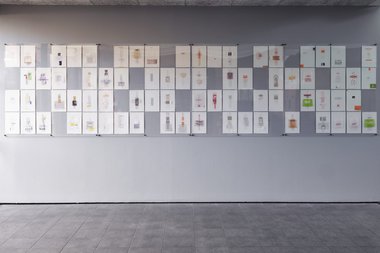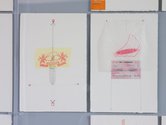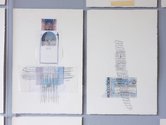John Hurrell – 17 June, 2021
Parallel drawn lines, pieces of tape, airy diagrams, snippets of text or brand logos, multiple patterned pinholes and leaning pencil strokes: all these and more are elegantly integrated within these paper rectangles. The spacing is irregular within each of the four rows, and carefully considered gaps are built in to break the density. The colour is restrained, and usually linear in form with diffuse textures and transparent surfaces.
Pakuranga
Louise Stevenson
Someplace Else
Curated by Andrew Kennedy
30 May - 22 August 2021
Presented on what is often called ‘The Drawing Wall’, Louise Stevenson sets out a grid of 73 pages, each one a delicate collage that usually involves a paper or plastic pocket, or the folded back shutters of a cut window. Each page incorporates paper or plastic detritus connected with public transport, the hospitality industry, museums, or tourism. Most of the sources are from Central Europe, especially Hungary, although some of her clusters of lines (it might be argued) show an awareness of the architecture of Melanesia. She was raised in the Solomon Islands.
Parallel drawn lines, pieces of tape, airy diagrams, snippets of text or brand logos, multiple patterned pinholes and leaning pencil strokes: all these and more are elegantly integrated within these paper rectangles. (They sometimes deceptively look embossed or printed.) The spacing is irregular within each of the four rows, and carefully considered gaps are built in to break the density. The colour is restrained, and usually linear in form with diffuse textures and transparent surfaces. They are a wee bit like miniature Rauschenbergs, but fainter. Individually they draw you in. They are surprisingly intimate.
Unusually, these drawings have a subtle three dimensionality, especially, with bent folded paper and swelling translucent plastic. To protect them from children’s grubby fingers, and to point out the notion that collectively they make up an artist’s book, a large sheet of plate glass is positioned on the wall, but hovering in front of them; not touching.
Focussing on ‘non home-base’ geographic spaces—as the title suggests—these ‘abstract’ drawings revel in tremulous stacked (often broken) pencil lines and peek-a-boo stitched cotton, as much as collages with fragmented ‘found’ design elements. Cut shape plays a minor role; blocks of solid colour don’t dominate.
In these works, Stevenson‘s pleasure in making marks by hand is conspicuous, and seems to heighten her delight in recalling the visiting of certain cities and districts. It exacerbates the intensities of memory by visually celebrating travel and perpetuating a physical process: the manual placing and tweaking of formal elements cut from accumulated daily receipts, direction-finding aids, product packaging or admission tickets: the mixing in (through such materials) of released emotion and evoked excitement.
John Hurrell





 Advertising in this column
Advertising in this column Two Rooms presents a program of residencies and projects
Two Rooms presents a program of residencies and projects



This Discussion has 0 comments.
Comment
Participate
Register to Participate.
Sign in
Sign in to an existing account.